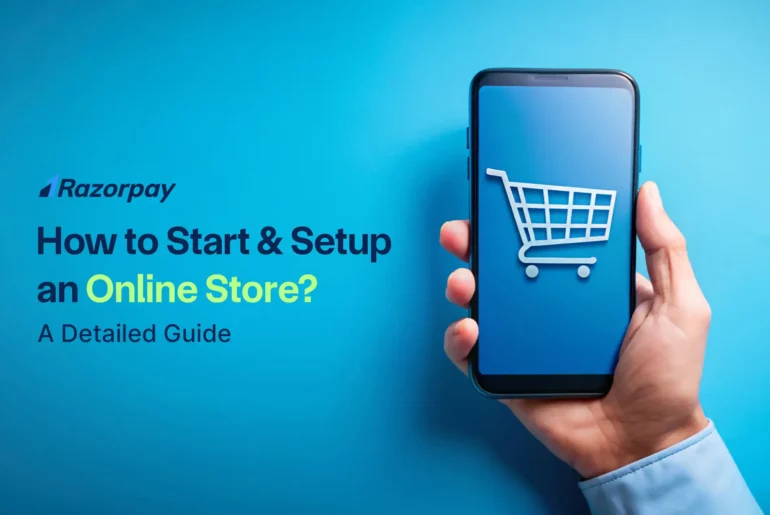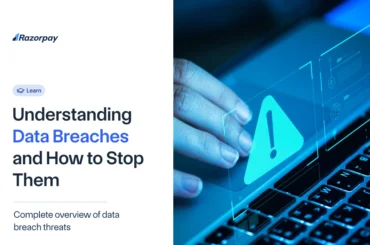Starting an online store in 2025 involves a few key steps: selecting the right e-commerce platform, setting up your website, and managing logistics like inventory and payment processing. In this guide, you’ll find a step-by-step approach to launching your online store, from choosing a domain name to marketing your products effectively. This article will cover everything required on how to set up an e-commerce business in India successfully.
Table of Contents
1. Identify A Niche And Define Your Target Audience
When selecting a niche for your online store, it’s crucial to align it with both market trends and your personal interests. Consider these three important factors when choosing your niche:
- Profitability: Research niches that show strong market demand but have manageable competition. This ensures that your business has the potential for good profit margins.
- Searchability: Use tools like Google Trends, SEMrush, or Ahrefs to analyze search volumes and trends. A niche with high searchability will attract more organic traffic to your store, making it easier to reach potential customers without heavy reliance on paid advertising.
- Passion: Choose a niche that aligns with your personal interests. Your passion for the topic will help sustain your enthusiasm and commitment to the business over the long term, even when challenges arise.
Once you’ve identified your niche, it’s important to clearly define your target audience. Understanding their preferences, buying behaviors, and challenges will help you create more personalized marketing strategies and product offerings that effectively meet their needs, driving higher engagement and conversion rates. Competitor analysis is a key part of this process, as it helps you see what works (or doesn’t) for other businesses targeting the same audience.
Related Read: How To Start an Online Business Without Investment in 2025?
Related Read: How to Start a Beauty Salon from Scratch
2. Select What to Sell Online
When deciding what to sell online, it’s essential to explore a variety of product options that balance demand, profitability, and sourcing feasibility. Consider whether the products you’re interested in have consistent demand and if you can source them reliably at a cost that allows for healthy profit margins. Here are some tips to get started:
Market Research:
- Identify your target audience: Who are you trying to reach with your products? What are their interests, needs, and buying habits? The more specific you are, the easier it is to tailor your product selection to their needs.
- Analyze market trends: Use research tools to identify current trends and popular products in your chosen niche. Google Trends, Pinterest, and Instagram can give you insights into trending topics and products.
- Assess competition: Identify your competitors and analyze their strengths, weaknesses, pricing, and marketing strategies. This will help you position your products in a way that stands out.
Product Viability:
- Demand: Assess the demand for your products by conducting market research and analyzing customer feedback. Before finalizing your product list, consider running small test batches or gathering feedback through surveys to gauge interest and ensure product viability.
- Competition: Identify your competitors and analyze their pricing, product offerings, and marketing strategies. This will help you understand the level of competition and identify gaps in the market.
- Profitability: Calculate your potential profit margins, considering factors like product cost, shipping expenses, and marketing costs. Be sure to account for any unexpected expenses, such as returns or customer service.
Sourcing Products:
- Manufacturing: Consider manufacturing your products in-house or outsourcing production. In-house production gives you control over quality but may require significant upfront investment.
- Dropshipping: Partner with suppliers who handle product fulfillment and shipping. This option has lower overhead costs but may present challenges in quality control and shipping times.
- Wholesale: Purchase products in bulk from wholesalers and resell them. This offers better profit margins than dropshipping but requires managing inventory and shipping.
Product Differentiation:
- Unique features: Highlight the unique features and benefits of your products. This could be anything from superior materials to innovative designs.
- Quality: Ensure your products meet high-quality standards. Product reviews and customer feedback can be valuable in building your reputation.
- Branding: Develop a strong brand identity to differentiate your products from competitors. Your branding should reflect your values and resonate with your target audience.
3. Determine On Your Business Structure
Choosing the right business structure is a critical step in starting an online store. The structure you select will impact your legal obligations, tax liability, and ability to raise capital.
Key Considerations
- Liability Protection: Consider whether you want to protect your personal assets from business debts.
- Tax Implications: Understand the tax implications of different business structures and how they affect your tax liability.
- Management and Control: Determine who will have control over the business and how decisions will be made.
- Capital Raising: Consider how your business structure will affect your ability to raise funds for growth.
Common Business Structures
Sole Proprietorship
- Definition: Sole proprietorship is a business owned and operated by a single individual.
- Pros: Simple to set up, complete control, minimal paperwork, pass-through taxation (profits and losses are reported on your personal tax return).
- Cons: Unlimited personal liability, limited access to capital, difficulty in attracting investors.
Limited Liability Company (LLC)
- Definition: LLC is a business structure that combines the pass-through taxation benefits of a sole proprietorship or partnership with the limited liability protection of a corporation.
- Pros: Limited liability, flexibility in management structure, pass-through taxation (default), potential for favorable tax treatment.
- Cons: Can be more complex to set up and maintain than a sole proprietorship, may require annual fees or filings.
Partnership
- Definition: Partnership firm is a business owned by two or more individuals who share profits, losses, and responsibilities.
- Pros: Shared resources, expertise, and decision-making, potential for increased capital.
- Cons: Shared liability, potential for disagreements among partners, complex tax implications.
Corporation
- Definition: A legal entity separate from its owners.
- Pros: Limited liability, potential for tax advantages (e.g., C-corporation vs. S-corporation), ability to raise capital through stock issuance.
- Cons: Complex setup and maintenance, higher costs, double taxation (for C-corporations).
Additional Considerations:
- Consulting with Professionals: Seek advice from legal and financial professionals to ensure you choose the best structure for your business.
- State-Specific Requirements: Be aware of the specific requirements for your state or region regarding business structures.
- Future Plans: Consider how your business may evolve and choose a structure that can accommodate future growth.
4. Register Your Business
Legal and Tax Considerations
Registering your business is a crucial step in establishing a legal entity and complying with government regulations. This process involves several key steps:
- Business Name Registration: Choose a unique and available business name and register it with the appropriate government agency (e.g., Secretary of State in the US, Registrar of Companies in India).
- Tax Identification Numbers: Obtain the necessary tax identification numbers (e.g., EIN in the US, GSTIN in India) for tax purposes.
- Licenses and Permits: Research and acquire any required licenses or permits specific to your industry and location. This may include business licenses, sales tax permits, and industry-specific certifications.
Additional Tips:
- Consult with Professionals: Seek advice from legal and tax professionals to ensure compliance with all regulations.
- Consider Professional Services: Explore the option of hiring a registered agent or accountant to assist with the registration process.
- Online Resources: Utilize online resources and government websites to access information and complete the registration process.
Need help with company registration? Razorpay Rize offers comprehensive business registration services, simplifying the process and ensuring compliance.
5. Choose An E-commerce Platform
Selecting the right e-commerce platform is critical for your business’s success. Whether you’re just starting or looking to scale, several platforms offer distinct features tailored to different needs.
Squarespace
Ideal for those seeking an all-in-one solution, Squarespace offers user-friendly website building with integrated e-commerce capabilities. Their plans start at $25/month, providing a seamless setup for showcasing products or services online.
Shopify
Renowned for its robust features and customisation, Shopify is perfect for dropshipping businesses. With advanced tools for managing inventory, marketing, and customer engagement, Shopify’s basic plan start at ₹1,994/month, catering to businesses that prioritize scalability and growth.
Square
For businesses on a budget, Square provides a cost-effective solution with free plans. It’s particularly suited for businesses that plan to sell both online and in-store, offering a simple setup with essential e-commerce features.
Key Considerations for Selecting An E-commerce Platform
Platform Features
When choosing an e-commerce platform, consider essential features like inventory tracking, mobile responsiveness, and a user-friendly interface. These features ensure a seamless shopping experience for your customers, enhancing engagement and reducing cart abandonment.
Cost Effectiveness
Balancing features and affordability is crucial. While higher-end platforms offer extensive tools, there are budget-friendly options that still provide excellent value. Evaluate what your business can afford while ensuring that the platform meets your operational needs.
Functionality
The platform’s functionality, including order processing, customer support, and integration with third-party tools, is vital. Effective integration can streamline operations and improve customer satisfaction, leading to repeat business.
Scalability and Customisability
As your business grows, so will your e-commerce needs. Choosing a platform that can scale with increased traffic, products, and transactions ensures that your business can expand without outgrowing its platform. Customisability allows you to tailor the platform to meet your unique requirements, supporting long-term success.
6. Get A Domain and Hosting
Securing the right domain name and reliable hosting are crucial steps in launching your online store. These elements form the foundation of your website, influencing everything from brand perception to site performance.
Choose Your Domain Name
Select a domain name that is short, memorable, and reflects your business identity. A good domain name should be easy to spell, pronounce, and type, helping users find your store effortlessly. Avoid complex words, numbers, or hyphens, which can lead to confusion. Use domain registration services, such as GoDaddy or Namecheap, to check the availability of your desired domain name. Additionally, consider registering multiple variations (e.g., .com, .net, .store) to protect your brand from competitors or copycats.
Select a Reliable Hosting Provider
Your hosting provider is essential to your online store’s performance, security, and scalability. A dependable hosting service ensures your website is accessible 24/7, with fast loading speeds and minimal downtime. When choosing a provider, prioritize features like:
- Uptime Guarantees: Look for providers that offer at least 99.9% uptime to ensure your store remains online consistently.
- Speed: Faster loading speeds enhance user experience and improve your site’s SEO ranking. Hosting providers with optimized servers and caching solutions can boost your site’s performance.
- Security: Choose a host that offers robust security features, including SSL certificates, malware protection, and regular backups, to safeguard your customer data and transactions.
- Scalability: As your online store grows, you may need more resources. Opt for a hosting plan that allows you to scale up as your business expands.
Recommended Hosting Providers:
- Bluehost: Known for its strong uptime, excellent customer support, and beginner-friendly interface, Bluehost offers scalable plans suitable for growing businesses.
- Hostinger: Offers affordable hosting with fast load times and solid security features, making it a great option for new online stores.
- Kinsta: A premium hosting provider focused on speed, security, and scalability, Kinsta is ideal for larger online stores that require high performance.
Investing in a high-quality hosting provider is essential to ensure your store runs smoothly and securely, providing a seamless shopping experience for your customers.
7. Build Your E-Commerce Website
Building an attractive, functional, and user-friendly e-commerce website is key to your online store’s success. Your website is often the first interaction customers will have with your brand, so it’s essential to make a strong impression. Focus on the following aspects to create an engaging and seamless online shopping experience:
Create a Visually Appealing Design
The design of your website should reflect your brand’s personality while ensuring a positive user experience. Choose a clean, modern layout that is easy on the eyes and ensures smooth navigation. Incorporate high-quality images and a consistent color scheme to reinforce your brand’s identity. Make sure your design is responsive, meaning it looks great and functions smoothly on all devices, including desktops, tablets, and smartphones.
Focus on User Experience (UX)
A well-designed website makes it easy for customers to browse products, find information, and complete purchases. Prioritize intuitive navigation by organizing your categories logically, creating clear calls to action (CTAs), and simplifying the checkout process. Implement search functionality and filtering options to help users find products quickly. The easier it is for customers to shop, the more likely they are to convert.
Feature a Professional Business Name and Logo
Your business name and logo are the cornerstones of your brand identity. Display them prominently on your website to establish a professional image and build trust with visitors. Ensure that your logo is high-resolution and aligns with your overall website design. Consistent branding across your website helps reinforce your business in the minds of customers.
Integrate Essential E-Commerce Features
Incorporate essential e-commerce features like shopping carts, product pages with detailed descriptions and images, and a secure checkout system. You may also want to include features such as customer reviews, wishlists, and product recommendations to enhance the shopping experience.
Optimize for Mobile Users
With a significant portion of online shopping happening on mobile devices, it’s essential to ensure your website is optimized for mobile users. A mobile-friendly site should load quickly, display correctly, and allow for seamless browsing and purchasing. Test your website on different devices to confirm that it functions smoothly on both mobile and desktop platforms.
8. Set Up Payment Gateway and Shipping Options
Setting up a reliable payment gateway and shipping options is essential for ensuring a smooth shopping experience for your customers.
Implement Razorpay Payment Gateway for Secure Transactions
Razorpay Payment Gateway offers robust encryption and fraud protection, ensuring secure transactions on your online store. It supports a variety of payment methods, including credit cards, UPI, and digital wallets, giving your customers flexibility and increasing the likelihood of completed purchases. Integrating Razorpay into your store helps build trust and provides a seamless checkout experience.
Establish Shipping Rates and Methods
Set up shipping rates based on factors such as product weight, destination, and service level. Choose from various shipping methods, including courier services, postal options, or self-delivery, depending on your business model. Competitive and transparent shipping rates can improve customer satisfaction and reduce cart abandonment.
Offer Free Shipping and Incentives
Offering free shipping is an effective way to attract customers. If free shipping is feasible for your business, consider setting a minimum order value to qualify. Strategic incentives like free returns or discounts on faster shipping can also enhance the shopping experience and encourage repeat purchases.
9. Launch Your Marketing Campaigns
Marketing campaigns are crucial for promoting your online store and reaching potential customers. These campaigns involve various strategies to build brand awareness, engage your audience, and drive traffic to your site.
Organic Marketing
- SEO: Optimising your website for search engines helps improve its visibility in search results. Effective SEO practices increase the likelihood of attracting organic traffic, which can enhance your store’s online presence and search rankings.
- Email Marketing: Use email marketing to connect with your audience through targeted campaigns. It’s a powerful tool for nurturing customer relationships, sharing promotions, and driving repeat sales by keeping your brand top-of-mind.
- Social Media Marketing: Leverage social media platforms to engage with your audience and promote your products. Platforms like Facebook and Instagram enable you to reach a wide audience with visual and interactive content, enhancing customer engagement.
- Loyalty Program: Implement a loyalty program to reward returning customers. This can include discounts, points, or special offers, encouraging repeat business and fostering long-term customer loyalty.
Paid Marketing
- Google Ads: Google Ads allows you to place ads that appear in search results and on relevant websites. This method targets potential customers based on their search queries, driving more focused traffic to your online store.
- Facebook and Instagram Ads: Use Facebook and Instagram Ads to target specific audiences based on their interests and demographics. Visual ads on these platforms can capture attention and drive engagement, helping you reach potential customers effectively.
10. Managing and Growing Your Online Store
Inventory Management
Effective inventory management helps you maintain optimal stock levels and avoid both shortages and overstock situations. Employ tools to track inventory, manage supply chains, and forecast demand accurately.
Customer Service
Deliver exceptional customer service by offering multiple support channels, such as chat, email, and phone. Prompt and helpful responses to customer queries build trust and enhance satisfaction.
Analysing Performance
Regularly review your store’s performance metrics, such as sales, website traffic, and conversion rates. Use this data to identify trends, measure effectiveness, and make informed decisions to optimise your operations.
Scaling Your Business
As your business grows, explore ways to scale up operations. This could involve expanding your product range, targeting new markets, or enhancing your marketing efforts to support increased customer demand.
Related Read: How to Start a Pharmacy Business?
Related Read: Profitable Side Business Ideas You Can Start Today
Frequently Asked Questions
Q1. How much does it cost to start an online store?
The cost to start an online store can vary widely. Initial expenses typically include e-commerce platform fees, website design, domain registration, and hosting. On average, you might spend anywhere from a few thousand to several lakhs of rupees.
Q2: How can I start an online business with no money?
Starting an online business with no money is possible by utilising free or low-cost resources. Opt for free website builders or platforms with minimal initial costs. Focus on organic marketing techniques such as SEO and social media. Dropshipping can also be a cost-effective model as it eliminates inventory expenses.
Q3: Where can I find affordable products for my store?
Affordable products can be sourced from wholesale suppliers, dropshipping platforms, and manufacturers. Websites like Alibaba, IndiaMart, and wholesale directories offer a range of products at competitive prices.
Q4: What is the best site to start an online store?
The best platform to create an online store depends on your needs. Shopify is excellent for comprehensive e-commerce solutions, while Squarespace is known for its design-oriented features. For budget-conscious options, consider Square, which provides cost-effective plans.
Q5: Is it profitable to have an online store?
Yes, running an online store can be profitable if managed effectively. Success relies on factors such as product selection, pricing strategy, marketing, and customer service. With a well-executed business plan and strategic efforts, an online store can generate substantial profits.
Q6: Do I need a business licence to start an online store?
In most regions, a business licence is required to operate legally. The specific licencing requirements depend on your location and business nature. Consult local regulatory authorities to determine the necessary licences for your online store.
Q7: What payment methods should I offer in my online store?
To cater to different customer preferences, offer a range of payment methods. Standard options include credit/debit cards, digital wallets (such as PayPal and Razorpay), and bank transfers. Providing multiple payment options enhances convenience and security for your customers.
Q8: What is dropshipping, and is it suitable for my business?
Dropshipping is a model where you start an online store without inventory. When an order is placed, the product is shipped directly from the supplier to the customer. This model is suitable for businesses with limited upfront investment but requires effective supplier management and marketing to succeed.





